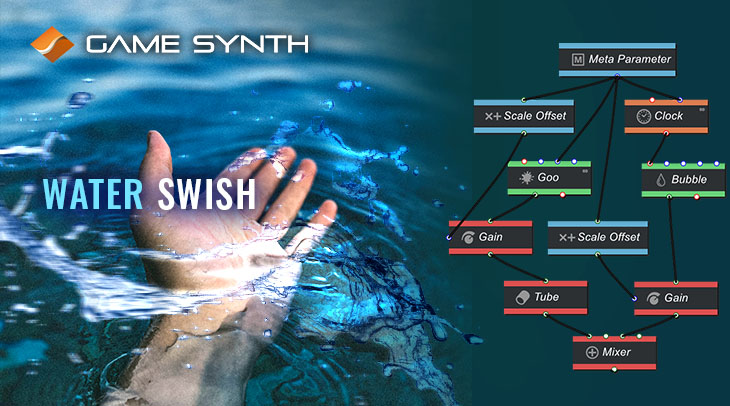Synthesizing water can be tricky. It’s neither particularly noisy, nor is it incredibly harmonic. Fortunately, GameSynth has several modules available for designing convincingly watery sounds. And, with the right control and signal processing, we can create a system that not only sounds great but is also performable.
Sound Generation
The three source generators in this patch are Rain, Bubble, and Goo. They all perform a similar role but offer textural variation when combined. Goo offers a gentle but slightly turbulent water generator, which sounds like a running tap. We can control its Frequency parameter, where lower values create a sense of submersion, and its Density, which affects the apparent quantity of the water flow.
Rain can create a similar effect to Goo, with less real-time control but more customization potential in the editor. If we start by turning the Close and Far shower distance to 0, we are left with the more distinct rain drips: Heavy, Light, and Close. The end result of these components is greatly affected by the material, impact amplitude, and inside/outside sliders. However, generally speaking, Heavy is lower in pitch, Light is higher in pitch, and Close refers to the punctuating droplets. Material determines what the rain is impacting, so the Lake setting works quite well for liquid sounds. The impact amplitude then controls how much of an effect the material will have on the sound, and the inside/outside can be used to quickly lowpass the final result.
Finally, we have Bubble. This generator is like a more customizable version of Rain’s Close Drip component. It creates individual bubble sounds, where radius determines its pitch, and rise modulates this pitch to create that familiar plip sound. The benefit of having a one-shot generator is that applying randomization to the sliders will affect each trigger event, rather than only applying at the start of playback. We can also control precisely how often it should trigger, giving us a bit more granular control.
Processing
When designing natural sounds, we generally want to avoid too much processing. Much of this patch’s processing is done by tweaking the settings within each generator. However, some EQ is used to balance the tonal elements where necessary. The Tube is also an excellent tool for creating some unique spatial characteristics. Since our patch is simulating an intimate sound source, it seems reasonable that there might be some nearby complex reflective geometry, like some rocks. Applying gentle processing with this module can help a sound source feel like it belongs in a real location.

Control
Although it might be sufficient to directly control each of our sources’ amplitudes directly, using a Gain module gives us more explicit control. Also, in the case of our Bubble generator, it ensures we can easily apply randomization to the Amplitude of each trigger while still having control over the overall envelope.
A Clock module is the ideal trigger generator for our Bubble since we can freely control the Frequency in real-time. We can also set an amount of Variation between triggers to make it sound more natural.
We can then link up everything we need to control with one Meta Parameter. The level of each Gain module is an obvious choice, and so is the Clock‘s Frequency. However, any other input could also be controlled for added effect. Frequency and Density both seem good choices when considering swishing around water. Some additional Scale Offset manipulation then helps ensure all the values are in their correct range and that the final result plays cohesively.



















